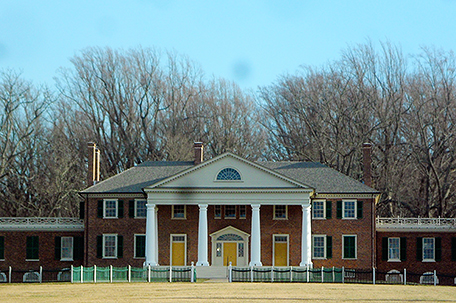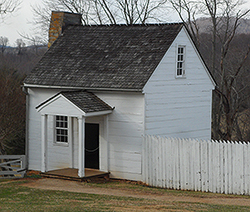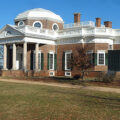
ABOVE PHOTO: Montpelier
By Renée S. Gordon
“No, they stay with their indulgences, happy, because contented, until death leaves the log cabin free for other occupants!”
–1824 Mary Cutts
Charlottesville’s Main Street serves as a modern reminder that it began in the early 1700s as Three Notch’d Road, and prior to that as an Indian trail. Shops, inns and ordinaries lined the road to service traveler as they headed further west. The Historic Downtown Charlottesville Mall, a brick, eight block long, pedestrian walkway, lined with trees like its predecessor, is a lure to both travelers and residents alike. There are more than 150 unique dining, shopping and entertainment venues located inside historic structures. In keeping with the concept of a “community living room,” there are very few chain stores and a farmer’s market each Saturday. www.downtowncharlottesville.net
Charlottesville was designated the “Locavore Capital of the World, by Forbes Magazine and it is renowned for not only the use of the freshest local ingredients but for its variety of eateries from fine dining to pizzerias. Definitely include meals as an integral part of your travel itinerary.
The Local serves contemporary American cuisine in seven dining areas created from ingredients provided by local growers. A large variety of drinks are offered, wines and craft beers from local vineyards and breweries. The food is delicious, the portions are large and the service is wonderful. What more could you ask for? www.thelocal-cville.com
C&O Restaurant was established in 1976 and has been “the” place to dine since then. There are six distinctive dining areas including the Mezzanine, with an original Finnish soapstone wood stove, intimate atmosphere and the Bistro, with walls and bar crafted by an artisan reusing wood salvaged from an area barn. The menu consists of exquisite dishes, both in taste and appearance, prepared from locally sourced products. C&O has been the recipient of the Wine Spectator’s Award of Excellence annually for nineteen years. www.candorestaurant.com
 PHOTO: Kitchen slave quarters Monroe
PHOTO: Kitchen slave quarters Monroe
Oakhurst Inn, a 28-room boutique hotel, is within walking distance of Main Street and historic attractions. The rooms are creatively decorated and offer all of the standard amenities, WIFI and parking. The staff is particularly hospitable and willingly provides directions, maps and suggestions. A contemporary café is onsite and prepares gourmet breakfast and brunch. Oakhurst is tucked a away gem just for the discerning traveler. www.oakhurstinn.com
Virginia is the fifth largest producer of wine in the country and is referred to as “the Napa Valley of the East.” Like many of Charlottesville’s regional attractions the history of wine growing is historic. Jefferson planted vines at Monticello and attempted to produce a homegrown wine. The Monticello American Vitacultural Area (AVA) is made up of one-third of the state’s vineyard acres and the Monticello Wine Trail is comprised of 30 distinctive wineries. They invite you to taste their wines and enjoy unsurpassed views of the Blue Ridge Mountains. www.monticellowinetrail.org
Dr. Thomas Walker, a friend of Jefferson’s, constructed the first section of his home, Castle Hill, in 1764. In 1781 the house was in British General Tarleton’s path as he marched to arrest Jefferson. Walker’s wife stopped them and convinced them to have lunch with her on the grounds because she was a loyalist, giving Jack Jouett enough time to warn them. She served them a meal and hard cider from the plantation. The brick portion of the mansion was added in 1824 with a further addition in 1844. The grounds and gardens are noted for their beauty and it is the oldest privately owned estate in the country.
In 2005 Castle Hill was purchased for preservation, in 2010 they established a cidery and in 2011 Castle Hill Cider opened. They produce 4500 cases annually using the world’s oldest fermentation vessels and methods more than 7,000-years old. They build on the hard cider heritage of the region including the use of heirloom varietals and an 80-year old vineyard. The popularity of draft ciders is growing rapidly because of the health benefits and use of natural ingredients and Castle Hill is one of the top cider producers in the nation. Visitors can sip their seven ciders in the beautifully appointed tasting room. Castle Hill’s ciders can also be purchased on-site or in Pennsylvania stores. www.castlehillcider.com
The Boar’s Head Inn is the “Official Hotel of the University of Virginia” and has been designated a Historic Hotel of America. The menu of offerings includes 175 guest rooms, four on-site restaurants, the Boar’s Head Spa, sports club, fitness center and an 18-hole golf course with natural terrain. For 13 consecutive years the Boar’s Head has been awarded the prestigious AAA Four Diamond Award.
The Old Mill Restaurant has been awarded the AAA Four Diamond Award for 27 consecutive years and the service, cuisine and ambiance are outstanding. The restaurant is a reconstruction, using original timbers, of an 1834 gristmill. www.boarsheadinn.com
James Monroe, fifth president of the United States, was born in the Virginia colony in 1758, the son of a tobacco farmer who died when James was 16 and left him his property and at least one slave. He soon enrolled in the College of William and Mary but dropped out to join the patriots in the Revolutionary War and was wounded at the Battle of Trenton. In the famous painting of Washington crossing the Delaware Monroe is the 18-year old soldier in the boat bearing the flag. When the war ended he continued his studies by “reading the law” under the tutelage of Thomas Jefferson leading too a deep and lasting friendship. Monroe served two terms as president and during his second term he presented to Congress the Monroe Document, the legislation for which he is most remembered. He is considered the final one of the founding fathers to serve as president.
Ash Lawn-Highland, James Monroe’s plantation, was originally part of the Blenheim Estate bordering Jefferson’s Monticello to the south. Monroe purchased 1,000-acres, which he ultimately expanded to 3,500-acres, for 1,000-pounds in 1793. He called the estate Highland and he and his family moved there in 1799 and resided there for the next 24-years. In 1825, Monroe was compelled to sell Highland to repay debts he had incurred in the course of government service for which he was never reimbursed. After the death of his wife Monroe moved to New York to live with his daughter. He died, debt free, there on July 4, 1831. He was the third president to die on the 4th of July.
The original house was a single story, 2-room, wooden dwelling. In 1816 he added an upper story. A subsequent owner added a Victorian section in 1870. Thirty-five minute tours of the home’s interior are guided and include five rooms of the main house, two rooms of the Victorian addition, the basement and the warming kitchen. Many of the furnishings are original to James Monroe or the family. The bed is a 1786 original and other highlights include the gown worn by Elizabeth Monroe to the coronation of Napoleon where they were the only Americans present. Monroe was governor of the state during Gabriel Prosser’s Slave Rebellion and there is evidence on display, in the form of correspondence with England’s leading abolitionist William Wilberforce, that he was ambivalent about slavery.
A feature of an exterior tour of the 535-acre grounds is an interpretation of slavery on the Monroe plantation. He owned between 30 to 50 slaves, 12-15 of which were house slaves. In the rear of the house there is a reconstructed domestic slave quarter and an original overseer’s cabin. www.ashlawnhighland.org
The Father of the Constitution, James Madison, was born on the Montpelier estate, 4675-acres of land deeded to his grandfather in 1723. The original portion of the existing home, a brick, two story, dwelling, was built by Madison’s father in 1760. In 1794, he married Dolley Todd, a Quaker widow, in Philadelphia. Three years later the couple moved to Montpelier and added a two story wing as a separate living space and four columned portico for visual unity.
In 1801 Madison inherited the estate including 108 slaves and eight years later he moved to Washington to serve as the fourth president. He died in 1836 and was buried on the grounds. Dolley Madison inherited Montpelier and sold land to avoid selling the slaves. In 1844, she sold the estate out of the family when she moved to Washington, D.C. to live in genteel poverty. The mansion had a series of owners until purchased in 1900 by William du Pont. The estate became the property of the National Trust for Historic Preservation in 1983.
There is ongoing restoration but house tours are offered. The mansion is being restored to its 1820s appearance and vigorous efforts are being made to reclaim furnishings and authenticate textiles, wallpaper, etc. On the tour emphasis is placed on Monroe’s contribution to the research and penning of the founding documents. There is a 10-minute orientation film and exhibits in the visitor’s center.
Visitors have access to three miles of historic nature trails and the James Madison Landmark Forest, 200-acres of wilderness with National Historic Landmark designation.
Montpelier currently consists of 2,650 of its original acreage and, just as the house is revealing its secrets, so to are the grounds on which hundreds of people, both black and white, labored. Archaeological excavations have identified the South Yard, where domestics lived and worked, field slave quarters and tobacco barns. Locations that have been unearthed will have structures rebuilt on-site using authentic techniques. Montpelier offers an opportunity to spend a week as part of one of four types of expeditions. No prior skills are necessary and all of the LEARN Archaeology Expedition Programs are led by the archaeology staff. This is a real opportunity to participate in hands-on history. www.montpelier.org
“A Colored Man’s Reminiscences of James Madison,” the first White House memoir detailing daily life, was written by Madison’s black valet, Paul Jennings. Jennings was born in the South Quarters in 1799 and was moved into the mansion to work as a child. In 1809 he accompanied the Madison’s to the White House. Jennings, as Madison’s personal valet, was present at all the major events in his life. He assisted Dolley Madison in her evacuation of the White House during the War of 1812 and was present at Madison’s death. After Madison’s death Senator Daniel Webster purchased Jennings freedom, allowing him to repay the loan. Jennings, who was literate, assisted escaping slaves by forging documents. He died in 1874.
The story of Montpelier’s enslaved community is interpreted beyond their emancipation and extends to Reconstruction and the era of Jim Crow. George Gilmore was born at Montpelier n 1810. When freed he lived on land owned Madison’s nephew in a hut that was constructed by the Confederates when they occupied the area. He constructed a wooden cabin in the 1870s for himself, his wife and eight children. He was a farmer and a carpenter and was literate. At the age of 91 he purchased the 11.1-acre property. His cabin, restored in 2011, is part of he Montpelier experience. It is fully outfitted as it would have been when the Gilmore’s lived there.
The historic Montpelier Train Station was built in 1910. At that time the law dictated that train stations had to include a post office. The station had both colored and white waiting rooms but, because federal law mandated desegregation, in the post office portion of the station the races were integrated. The station was restored and opened as an interpretive center in 2010. Narration is provided at push button kiosks with first person accounts of the experience.
Keswick Hall & Golf Club is one of the most awarded resorts in the area and accolades have included a place on Condé Nast Traveler’s prestigious Gold List and Forbes 2015 Travel Guide Star Awards. The current Italianate villa began in 1912 as the 17-room Villa Crawford, a private residence. The 8,000-sq. ft. mansion was constructed at a cost of $100,000 with such detail that even the switchplates were silver. In 1948 the villa became part of Keswick Country Club and remained private for the next 35-years.
In 1965, owner Knox Turnball altered the club membership rules to admit an African American. Membership went from 275 to 55 and then rose to 800. Sir Bernard Ashley, the widower of Laura who wanted to make the hotel feel like home, restored the hotel in the 1990s. Villa Crawford was incorporated in the design and is now the North Wing.
This luxurious hotel has 48 guestrooms, luxury linens, designer bath amenities and concierge services. On the grounds guests can avail themselves of the Spa at Keswick, seven tennis courts, Fitness Center, a Pete Dye Golf Course and several pools including an infinity pool with an outstand panoramic view. Fossett’s, the 4-Diamond Award winning on-site restaurant is named in honor of Jefferson’s cook. The list of luminaries who have stayed there is long and boasts such names as Freeman, Jagger, Newman, Woodward and McFerrin. www.keswick.com
Plan an extraordinary “presidential” visit to Charlottesville. Travel into history. www.visitcharlottesville.org
I wish you smooth travels!
TRAVEL TIPS:
Advances in technology are making traveling and staying connected increasingly easy and one of the best new devices is RazorMax by myCharge. Small enough to be held in one hand, this anodized aluminum powerbank, with two USB ports, gives the user an additional 27 hours of power and sustains a charge for up to 365 days. LED lights alert the user to the charge level and you need never worry about running out of power in the midst of an application. Information and photographs are available online. www.shop.mycharge.com/products/razormax
You can enhance your children’s education and summer experiences by enrolling them in Penn Museum’s Summer Camp. There are eight sessions and students can register for any or all of them. Hours are from 9:00 am to 3:00 pm, with optional pre and post camp care. Partial scholarships are offered. For information contact (215) 898-4016, or [email protected]. Registration is open.

















Leave a Comment